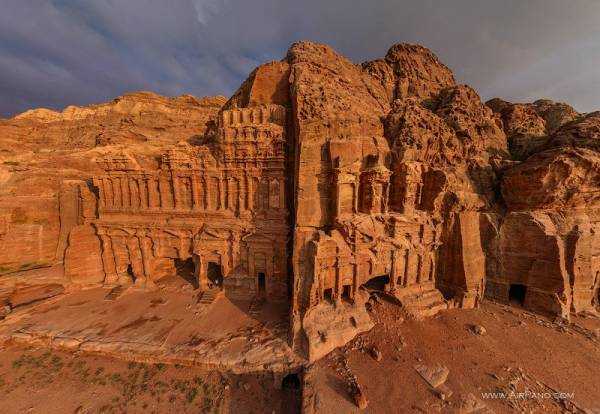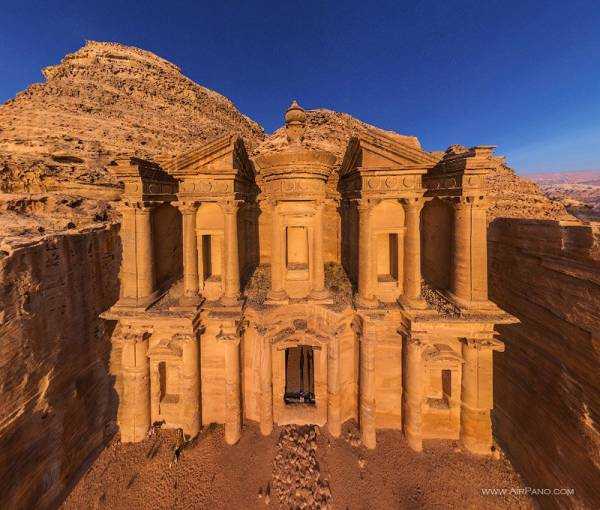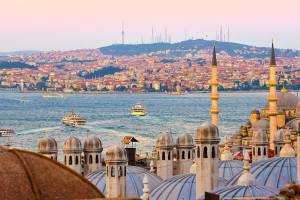Petra - the greatness of decline
The road out of the town was illuminated primarily by the full moon, and only secondarily by the lanterns placed along the side of the road. I walked in almost complete silence, not imagining what awaited me around the next turn. Strange dome-shaped rocks with caves carved into the thickness of the stone, in which candles stood, unfriendly saw me off with their glowing eye sockets to the city of the dead they guarded. The path ran into a cliff and turned into a narrow passage between vertical red walls. The moon could no longer illuminate anything, and I walked along a winding path, for a long time and in silence, accompanied only by the dim light of the lanterns placed along the path, gusts of warm wind and the rustling of lizards. Suddenly, a bright light dawned ahead, after a few meters the rocks parted, and I came out into a square filled with candles. In the center stood a man, dressed in white clothes down to his heels. He slowly raised his hands, and the music of the flute flowed out. It spread like a snake across the entire space, penetrated into the crevices, reflected from the yellow-red rocks and flew away to the endlessly starry sky. The majestic building against which the Arab stood – the Treasury of the Pharaoh – dominated the surrounding space. If it had walls, it could have been taken for an ancient Greek temple. But there were no walls. The facade, columns, porticoes, statues, steps leading to the entrance to the dark interior were carved with incredible care right into the rock… The bright flame of hundreds of candles spread over the square. It seemed (or maybe it was) that I was taking part in an ancient pagan ritual…

Petra... So I entered Petra for the first time several years ago...
A city living in four dimensions. Or rather, living... Consciousness refuses to accept that the overwhelming majority of breathtaking majestic rock "palaces" are just separate burials of a huge, centuries-old and multinational necropolis. It was so customary in ancient times (and a striking example of this is the Egyptian Pyramids) that burial structures were created for millennia, temple and religious buildings were designed for centuries, and household and residential buildings - for a period barely limited by human life, at best, the life of a family.
No, Petra was not created specifically as a necropolis: here, in the depths of the rocks, up to 20,000 people once lived, there were markets, baths, villas with swimming pools, an extensive system of water canals, theaters, government offices, a senate... It’s just that time and earthquakes, wind and sand destroyed and hid everything vain.

When you think about Petra, you want to introduce a special, “fifth” dimension, directed into the thickness of the rock: to describe the rooms, caves, storage rooms, altars, altars and obelisks carved out of the mountain massif over the centuries in ordinary geometric terms seems absurd.
Riddles of history
Everything here breathes time, as viscous as the stone steps to the huge altar on the highest cliff of Zibbi-Attuf, soaked in the blood of thousand-year-old human sacrifices to the sun god.
The Arabs who now inhabit Jordan are skeptical of the Old Testament as a historical document, and their guidebooks begin their descriptions with the settlement of the “hard-working Arab tribe of Nabataeans” in the Valley of Moses in the 4th century BC. A little later, the Greeks would call this area “Petra,” which means “rock,” “stone.”

The source of the Nabataeans' wealth was primarily caravan duties, payment for their protection and escort, tribute from neighboring nations, and banditry. Their influence extended from Sinai to Damascus, and rumors of a prosperous state attracted the attention of the Romans. At first, they were unable to conquer Petra: the city was too well protected by the surrounding mountains, and it was too easy to defend the passage into the city (then called Siq), only 2-5 meters wide, among 80-meter steep cliffs. But in 106 AD, the Nabataeans still lost the battle to the troops of Emperor Trajan.
Petra, now Roman, flourished for a couple of centuries, but with the development of shipping on the Red Sea, the city lost its importance, and the Romans left it. The Byzantines came to Petra already during its decline, and several particularly significant buildings were converted into Christian churches.

The conquest of the city by the Arabs in the 7th century did not leave much of a cultural or historical trace. The last mentions of Petra date back to the 11th century, the period of the Crusader Kingdom of Jerusalem, the ruins of whose fortress are located near the Main Altar of Sacrifice.
Since then, Petra seemed to have disappeared from the face of the earth for everyone. Only legends about the countless Nabatean treasures hidden somewhere in the dead city in the Jordan Mountains and the bloodthirsty Bedouins guarding them were passed from mouth to mouth...
Some parts of the legendary film “Indiana Jones and the Last Crusade”
Petra was discovered for us Europeans by the Swiss traveler Johann Ludwig Burckhardt in 1812. To do this, he had to learn Arabic and study the Koran. Outwardly, the adventurer looked like a Muslim. Perhaps that is why the Arabs agreed to show him the way to the rock city. Finding a guide was not easy: everyone was afraid to go to the city of the dead, inhabited, according to the Bedouins, by evil spirits. The guide led him to make a sacrifice to the Mausoleum of Aaron. After walking along the rock corridor and coming to the 40-meter Treasury carved into the rock, Burckhardt realized that this was the legendary Petra, and from admiration he almost gave himself away, starting to examine the magnificent structures. The guide even wanted to kill him, but the resourcefulness of the scientist saved his life...
Stone city, city in stone...
Those who have visited Petra will agree that one day is enough to love and admire this city, but three is not enough to walk along all its paths and see all its buildings, from the Treasury to the huge Monastery of Deir, carved out of the top of the cliff. After all, the Nabataeans alone left more than 800 stone-cut monuments in the city.

The entrance to Petra is through the Siq, a dark, winding gorge. Along one wall there is a kilometer-long canal cut right into it, through which water from the Spring of Moses flowed into Petra. Ancient architects developed for Petra a complex system of dams, cisterns, and aqueducts to collect and retain moisture in this hot area. Fountains gushed in the squares, and noble Nabataeans and, later, Romans enjoyed the sun by the pools, the remains of which have been excavated by archaeologists... It was impossible to imagine this, looking at the completely lifeless rocks under the scorching Jordanian sun.
Small carts pass by and tourists hurry, but it is better to go out to the Treasury of the Pharaoh slowly. The facade of this most beautiful building of Petra first appears slightly in the gap between the rocks, and then with each meter it opens up more and more until it appears shining in the sun in all its grandeur.

It must be said that the names of the monuments do not at all reflect their real purpose and content. Since the Nabataeans did not leave a city plan with names, the Arabs gave names based on myths, appearance or just guesses. So the Treasury received its name based on the legend of the rich loot of the ancient pharaoh, which was so heavy that it slowed down his army's journey to the east; he had to hide most of it in the rocks... On the bowl crowning the building, you can see traces of the bullets of the Bedouins, who were sure that this was where the gold was: you just had to break the bowl, and a rain of jewels would pour out on them...
Behind the columns are doors to the inner rooms. The small rooms are believed to have served as the burial vault of the great Nabataean king Arepa IV, during whose reign the city reached its peak, including in terms of architectural achievements. The coloring of the interior rooms is striking: sandstone deposits, from white to burgundy, seem to have been smeared by nature's brush on the walls of the tomb. The facade of this structure, 30 meters wide and 43 meters high, is carved out of a single rock and decorated with statues of Nabataean gods and goddesses. The treasury looks across the square directly onto the narrow crevice of the Siq, and it seems that Petra consists of a single building: all that is visible around it are red-pink rocks. But in fact, there is a passage to the side of it that unexpectedly widens around the bend and turns into a spacious road leading to the center of the ancient city. On both sides rise the facades of buildings carved into the rocks, which amaze with their monumentality.

It is believed that this “Street of Facades” was created during the era of Assyrian domination, and the builders borrowed many architectural features from the newcomers from the East. The road leads us to a huge amphitheater, built, or rather, carved directly into the rock. I was unable to count the number of seats; guidebooks indicate from 3 to 7 thousand. Initially, the theater was built by the Nabataeans for ritual purposes, and later expanded by the Romans for grandiose performances that attracted half the city.
The purpose of the rock structures is not exactly known. Many of the former tombs were later converted into dwellings and temples. There is no answer to the question: were all the structures tombs? Therefore, when describing Petra, I will use the terms that are established today, as is customary in modern Jordan.

Several roads diverge from the Amphitheater in different directions, and each leads to its own time. Turning right, you can get to the complex of impressive "Royal Tombs". Moving west, we will see the ruins of the Temple of Dushara - the supreme god of the Nabataeans. This is probably the only massive structure standing separately from the rock.
The trail then leads to a narrow gorge with a long (800 steps!) and steep staircase to the Ad-Deir Monastery, the largest building in Petra.
To go up through the gorge, we had to hire donkeys; however, a hardy traveler can cover this distance on foot. Made in the spirit of the Treasury, but with less detailed ornamentation and devoid of statues, the Monastery of Ad-Deir is noticeably wider. It is known for certain that in Byzantine times there was a Christian church here, since then this name has stuck. You can climb the rocks to the very top, to the urn, to appreciate the scale of the work of the Nabatean stonemasons and the grandiose view of the entire Valley of Moses. The only way from here is back, down...

From a distance, from the Monastery, the Royal Tombs seem small against the backdrop of the Jebel Qubta rock from which they were actually carved. The furthest one, dating to 126 AD, is the only tomb in Petra that has an inscription indicating who it was intended for: the Roman governor of Arabia, Sextius Florentinus. If you move from it towards the Amphitheater along the Wall of the Kings, you can see the Palace Tomb with its façade in the form of a Roman temple, the Corinthian Tomb, similar to the Treasury but badly damaged by time and earthquakes, and the relatively small Silk Tomb, whose walls are painted in all shades of yellow-red-gray sandstone and seem to be covered with a silk blanket that sparkles in the sun. The nearby Urn Tomb is no less tall than the Treasury or the Monastery. It is reached via a multi-story arched pedestal, intertwining staircases, and a side colonnade. The room behind the massive entrance, measuring 17 by 19 meters, is also striking, where you can take a break from the heat in the semi-darkness and coolness…
And my advice to those who read to the end: having arrived in Jordan, you can also spend a day at the Dead Sea, admire the sunset in the Wadi Rum desert, relax for a couple of days at the Red Sea, but the remaining time should be devoted entirely to walks around the city in the rocks.
Virtual tour
Spherical 360 video
For invaluable help in obtaining permission to shoot in Petra and moral support, we thank the wonderful photographer Ildara Yambikova.
For providing the AirPano team with the necessary documents, warm welcome and accommodation we are grateful to:
– To the head of the Rossotrudnichestvo representative office – A.A. Dorofeev;
– Acting Head of the Representative Office of Rossotrudnichestvo – V.I. Zaychikova;
– To the Head of the Information and Analytical Department of the Russian Center for Science and Culture – Sukhov N.V.
Source: travel.ru



